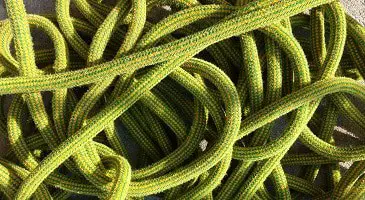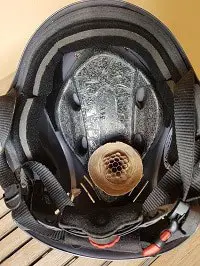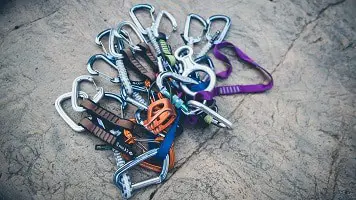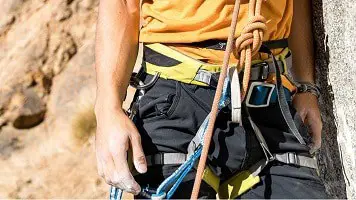Disclosure: Links marked with * are Affiliate Links. As an Amazon Associate, I earn from qualifying purchases if you decide to make a purchase through these links – at no cost for you!
As a climber, you need to know when to replace your gear, as it is your life insurance on the rock. Most climbing accidents are due to improper use of climbing equipment or the use of damaged or old equipment.
In this article, you will learn everything you need to know about inspecting your climbing equipment, how you can increase its life expectancy and when the inevitable point of disposal is reached.
When to retire a climbing rope?
 The lifespan depends above all on how often it is used and how well it is maintained. If the rope shows even minor damage, you should replace it.
The lifespan depends above all on how often it is used and how well it is maintained. If the rope shows even minor damage, you should replace it.
All manufacturers have to provide information on the lifespan of their climbing ropes. If you take good care of your climbing rope and store it well, you can follow these usual recommendations:
| Frequency of Use | Recommended Duration of Use |
| Never | 10 years |
| 1-2 times a year | 7 years |
| Once a month | 5 years |
| Several times a month | 3 years |
| Weekly | 1 year |
| Almost daily | Less than 1 year |
If these recommended values are exceeded, the climbing rope will not suddenly break – this information can rather be seen as the best before date. Only properties such as handling or elasticity become worse and worse in the long run due to material fatigue. After this period you have to decide for yourself to what extent the further use of the climbing rope is safe or not.
Do you need a new climbing rope*? –> How to Choose a Rock Climbing Rope
Increase the Lifespan of your Climbing Rope
With climbing ropes you can make quite a few mistakes in handling, storage and maintenance. These mistakes can quickly affect the safety of your climbing rope. If you climb very often, you should document damages, shortenings and the age of your climbing rope. This helps to better assess the condition.
For the full article on climbing rope care, click here. Otherwise are here the most important things you need to pay attention to when maintaining, storing and handling the climbing rope:
- Do not step on your climbing rope: The pressure you put on it with your foot can damage the internal structure and drive dirt into the rope.
- Avoid dirt: dirt inside the rope acts over time like sandpaper. As the rope stretches, the dirt particles rub against the fibers and roughen them. This can cause invisible internal damage.
- No sharp edges: At first glance, this is probably the most obvious tip, but also the most important! Not only metal can cut the climbing rope, but also sharp rock edges. Even if the rock does not look sharp and does not feel like it, it becomes dangerous for the climbing rope if it is guided over such a place with pressure. The rope should not touch the rock at all.
- Washing: To remove dust and other dirt from your climbing rope, you can wash it in a washing machine or by hand. In the washing machine, you have to put it in a closed bag so that the rope is not damaged. The washing machine should run on a long program with cold water without detergent. To dry, hang up the climbing rope loosely and let it drip off and dry in the air (no sun!). After it has been washed, you should not use the climbing rope within the next 24 hours – only when it is completely dry.
- Shorten the ends: The rope gets the highest load at its ends. There, too, knots and securing devices most often cause mechanical damage. Old climbing ropes almost always break at one of the two ends. To increase the lifespan of your climbing rope, you should therefore shorten the ends if necessary (always both at the same time so that the centre marking remains correct). Also remember when buying that you buy your climbing rope longer than needed to get the option of shortening it. The best way to cut a climbing rope is explained in this article.
Inspection: What’s not OK?
Your climbing rope is inspected visually and by feel. Your eyes are looking for dirt and surface damage. With your fingers, you feel the coat for unevenness. You can also feel hard spots inside the climbing rope. If you are not sure whether damage will render it unusable, you should dispose of it or get a second opinion from an expert you trust first.
You should always dispose of your climbing rope when one of the following things has happened:
- The coat is frayed or worn out.
- The coat slips over the core.
- The climbing rope has come into contact with chemicals. Acids of all kinds are particularly bad.
- The coat is so worn that you can see the core.
- The climbing rope is so dirty that it can no longer be washed clean.
- The climbing rope has hard spots or is rigid.
- Damage from heat or sun is visible.
- Severe mechanical stress. A climbing rope is like a spring or a spiral. The more often it is tensioned, the less elastic it becomes. Gradually it becomes less and less elastic until the remaining elasticity in a fall is reached at some point and the fall either ends very abruptly or the rope even breaks!
When to Retire a Climbing Helmet?

The highest life expectancy of climbing helmets is 10 years if he has never seen a rockfall or impact. If you climb very often in the sun, however, this time already halves to 5 years, since the UV radiation slowly destroys the materials of your helmet over time.
If there is obvious damage, you should replace it. If you have an accident and the helmet has saved you from serious injury but has no obvious damage, you should also consider disposing of it. The force of an impact does not always have to end in a break or dent – the helmet can also suffer internal damage.
Do you need a new climbing helmet*? –> How to Choose a Rock Climbing Helmet
Increase the Lifespan of your Climbing Helmet
Since the life expectancy of a climbing helmet drops directly to 0 if it is heavily strained, the best tip to prolong its life is probably not to have any accidents. But if it were that simple, we wouldn’t need a helmet. However, there are actually a few things that make your climbing helmet get older:
- Sun: As mentioned above, sun or UV radiation shortens the life of your climbing helmet. Therefore you should store your helmet in a dark place to avoid sunlight.
- Washing properly: You can wash the hard outer shell as many times as you like. Only use lukewarm (max. 30 °C) water on the inside. Use only as much soap as necessary, make sure that it is pH-neutral, mild soap and then wash the climbing helmet very thoroughly with clear, cold water.
- No stickers: The question of whether stickers can damage your climbing helmet is a matter of heated debate. Some say that the adhesive could be harmful or that the absorption of an impact no longer functions properly. However, manufacturers now offer stickers that have been tested especially for climbing helmets. There are also blanks on which you can stick your own!
Inspection: What’s not OK?

Before you go climbing, you should inspect your helmet thoroughly. If your climbing helmet has one of the following criteria, you will have to replace it:
- Damaged buckles, straps and other adjustment mechanisms: If these elements of your climbing helmet no longer work properly, the helmet can no longer protect you adequately. A loose helmet or buckle can be fatal.
- Damage to the outer shell: Smaller dents are OK – larger ones are not. Cracks, in particular, mean that the climbing helmet is no longer usable.
- Foam inside loose: If the foam inside the climbing helmet is loose, it has either come loose due to external influences or there is a manufacturing defect. No matter what the cause is, if the outer shell is not fixed to the inner part of the helmet, it is worthless.
- Bees/Hornets!
When to Retire Carabiners?
 There is no general maximum lifespan for metal parts, so they can accompany you throughout your climbing life with proper care and a little attention!
There is no general maximum lifespan for metal parts, so they can accompany you throughout your climbing life with proper care and a little attention!
Carbines* not only carry the rope along the rock, they also hold your weight and that of the person securing it. In the event of a fall, these forces multiply many times over and especially then all carabiners should function perfectly. They must not break apart and the opening must not be damaged or open by itself.
Increase the Lifespan of your Carabiners
- Do not drop from a great height: If a carabiner falls from a great height, it can get cracks that cannot be seen on the surface. These can then expand later under tension and cause the carabiner to fail. In general, a carabiner is disposed of immediately if it has fallen from a height of more than 5 m – no matter what the optical condition is afterward!
- Clean moving parts: It is a good idea to clean it regularly to ensure the correct functioning of the joint and the closing mechanisms over time. This is best done with a toothbrush or something similar.
- Load only vertically: Your carabiner has been designed to withstand the most force in its longitudinal axis when closed. Never load it with the gate open or sideways (which should be difficult solely because of the shape).
Inspection: What’s not OK?
You should check your carabiners regularly for function and optical impression. Here are a few things that make the carabiner unsafe:
- Cracks: Of course, cracks of all kinds are not okay. They could spread and break the carabiner.
- The lock does not work properly: If the lock no longer functions correctly, the rope can come loose on its own. There are different types of gates, so familiarize yourself with them and their proper function to detect a malfunction. The spring force of closing carabiners is also important.
- Sharp edges: Climbing ropes break mostly because of a sharp object. This object is usually a sharp rock edge, but a sharp piece of metal like a carabiner can also damage the rope so badly that it breaks under heavy load.
- Very worn: If the carabiner is already very worn out, rough areas can form, which roughen the climbing rope. Stainless steel is more or less indestructible. However, many carbines are made of aluminum, which is much softer and can actually be worn relatively quickly.
- Missing parts: Every part has a purpose in carabiners. If one is missing, the function is endangered. Especially small rivets or springs like to disappear first.
- Slackline or similar: If the carabiner was udes on a slackline or held heavy weights permanently in its previous life, it is no longer suitable for climbing.
When to Retire a Climbing Harness?
 The general life expectancy of climbing harnesses is 3-4 years with good care and normal use. If it is never used and perfectly stored, it is 7-8 years. If it is damaged in any way, it must be disposed of immediately. If you are a professional climber or climb almost daily for other reasons, you should replace your harness every year.
The general life expectancy of climbing harnesses is 3-4 years with good care and normal use. If it is never used and perfectly stored, it is 7-8 years. If it is damaged in any way, it must be disposed of immediately. If you are a professional climber or climb almost daily for other reasons, you should replace your harness every year.
Do you need a new climbing harness*? –> How to Choose a Rock Climbing Harness
Increasing the Lifespan of your Climbing Harness
To extend the lifespan of your harness, correct storage and care are of course very important. Here are some tips for care and storage of your harness:
- Washing: You can wash your harness in the washing machine in a gentle cycle (never above 60°C!). If detergent is necessary, make sure it is mild and does not contain bleach. Furthermore, the harness must not be dried in the sun. Before storing the belt, it has to be completely dry.
- Chemicals: The harness should never come into contact with aggressive chemicals such as bleach, petrol, battery acid or solvents. These can cause material damage that is not necessarily visible – which is particularly treacherous.
- Temperature: You should not only pay attention to the temperature when washing. The harness should never exceed 60 °C during storage. If you use a container for storage, it should not be in the sun. A car is therefore also not a good storage location.
- Sun: Direct sunlight should be avoided.
- Do it yourself: You have to resist the temptation to repair small damages yourself. Do not singe the threads that stick out. Repairing open seams is a no-go!
- Rodents: Last summer my hammock was eaten by a mouse in the shed…. I didn’t think it would be either, but rodents or certain pets can pose a danger to your climbing equipment. A gnawed-on harness can be dangerous.
- Falls: Mechanical stress, such as a fall, can also cause damage. Of course, this depends on the frequency and intensity of the impact. Since these damages can occur only internally, it is possible that a particularly hard fall and the associated force on the climbing harness make it unusable.
Inspection: What’s not OK?
Regular checking of your harness is extremely important. Just like the climbing rope, it is your life insurance in the event of a fall.
Examine the entire harness before and after each climbing session. A damaged climbing harness should no longer be used! Pay particular attention to this:
- Abrasion, cuts, holes
- Defective seams
- Burns
- Chemical burns
- Damaged buckles (burrs or sharp edges are dangerous with such metal parts, which can form by an impact with other metal or rocks. Such sharp spots can damage the rest of your harness or other equipment)
Safety Loop
Especially with the safety loop, which is designed to hook in the safety device, you have to be able to rely 100 percent on your equipment. Fortunately, every piece of equipment that can be purchased is also subject to strict testing procedures and requirements for personal safety.
The CE mark alone means that this loop of the climbing harness must withstand a load of 1500 kg for at least three minutes. Most products can usually withstand much more. If your harness is intact, you don’t have to worry about the safety loop tearing.
Nevertheless, you should pay particular attention to damage here. Cracks, incisions, defective seams and other severe signs of wear can impair the maximum load on the safety loop.
When to Retire Cords and Slings?
As with climbing ropes, the maximum lifespan is 10 years – even if they are perfectly stored and never used. Under normal use, the lifespan is three to five years, depending on how much they have been used.
Cords and slings* should not be repaired by hand. If they’re damaged, they go into the trash.
Inspection: What’s not OK?
Before each use, you should check your auxiliary equipment for damage. Here are a few things where you should dispose of them immediately:
- Ruptures
- Punctures
- If they were in a heavy fall.
- Burns
- Frayed
- Stiff parts
- Faded
When to Retire your Belay Device?
 The beleay device has to work perfectly. It should also not damage the rope. Remember the condition in which it was delivered. Over time, it will wear out and eventually lead to problems. This material loss due to the friction of the climbing rope can be observed very well.
The beleay device has to work perfectly. It should also not damage the rope. Remember the condition in which it was delivered. Over time, it will wear out and eventually lead to problems. This material loss due to the friction of the climbing rope can be observed very well.
I have also often heard the question of whether the frictional heat between the rope and the belay device can lead to damage. It is true that the individual components can suffer from high heat, but the heat generated during belaying is far from being harmful.
Do you need a new belay device*? –> How to Choose a Belay Device: Guide & Best of 2018
Increase the Lifespan of your Belay Device
You can dramatically increase the lifespan of your belay device by taking some care and attention:
- Clean all moving parts: To ensure that the belay device functions for as long a time as possible, it is recommended to clean the moving parts regularly (if it has any). Small particles of dust or stones can leave marks that can damage the climbing rope.
- Avoid scratches: Scratches or other sharp spots can damage the climbing rope. A climbing rope is many times more expensive than a new belay device. Before the rope is damaged, you should always replace the belay device first! Not only your wallet but also your climbing partner will thank you.
- Do not drop: Falls can damage the securing device from the inside, which can lead to cracks.
- Use belay carabiners the other way around: If you use a carabiner for belaying, you should occasionally use it at the small end to distribute the abrasion to both sides.
Inspection: What’s not OK?

The following things are not okay:
- Sharp spots: Sharp edges can damage the climbing rope.
- Function not perfect: …
- Too much material rubbed off: The manufacturers will usually tell you how much material is allowed to be gone. With carabiners it is usually recommended to replace the carabiner at the very latest when the diameter has halved.
- The safety device has fallen from a height of more than 5 m: Internal material damage can lead to failure during use.
Conclusion
If you are even a little unsure about the safety of your climbing equipment, you should discard it and get something new. Safety first!
Every climber knows the history of his climbing equipment and is responsible for keeping it in good condition and recognizing when a new piece is needed. For my part, I climb best when I don’t have to worry about my safety. By taking good care of your safety equipment and examining it before every climb, your head is clear too!
Here is a final note on the correct disposal of safety equipment: destroy or mark the item so that it can no longer be used. A rope or a climbing harness is best cut. This prevents further use by an unknowing climber. You can also use climbing ropes creatively – as a dog leash, doormat or as a rope for attaching your hammock.
Attention: You have to take care of your safety when climbing! The information on climbtheearth.com only helps you to learn. Before you climb, you should make sure that you have been properly instructed by an expert and that you follow all safety precautions.
Disclosure: This website is the property of Martin Lütkemeyer and is operated by Martin Lütkemeyer. Martin Lütkemeyer is a member of the Amazon Services LLC Affiliate Program, an affiliate advertising program designed to enable Web sites to earn advertising revenue through advertising and linking to Amazon.com. Links marked with * are affiliate links.